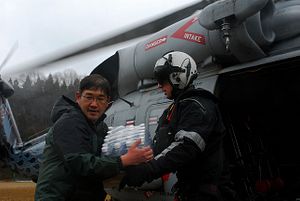Over the past two decades, China’s military modernization has emerged as a growing threat to U.S. interests in the Asia-Pacific region. To balance this threat, U.S. defense analysts have been reevaluating current military strategy for the region, which has centered on the forward basing of U.S. military forces along the Japanese archipelago. One notable proposal that has attracted considerable attention is offshore balancing, which would have the U.S. reposition its forces in Guam, Hawaii, and San Diego. From a military standpoint, these locations would put U.S. forces out of range of most Chinese counter-intervention threats. However, from a political standpoint the repositioning of U.S. forces would raise a series of issues that could endanger the U.S.-Japan security relationship.
For U.S. defense analysts, the biggest threat to American interests in the Asia-Pacific has been China’s military modernization and its ability to threaten U.S. forward deployed forces stationed in Japan. While U.S. forces in Japan maintain robust capabilities and a diverse range of firepower, Chinese investments in counter-intervention capabilities can greatly constrain U.S. forces ability to operate. The major concern of China’s military modernization has been its development of advanced conventional ballistic missiles and cruise missiles. China has also been greatly expanding its ISR capabilities to further improve the lethality of these systems. These counter-intervention systems pose a formidable threat to U.S. forward forces in the Asia-Pacific.
To balance this counter-intervention threat, U.S. analysts have proposed a number of strategies aimed at mitigating Chinese capabilities. One such approach would include further expanding fortifications at U.S. forward bases to strengthening anti-missile batteries in the region. Another, more controversial strategy is offshore balancing. Advocates of offshore balancing believe that forward based U.S. forces are detrimental to American interests in the region. They argue that it promotes regional balancing against the U.S. due to forward deployed forces and multilateral and bilateral security agreements cause a significant strain on U.S. finances as most partner nations fail to pay their fair share of the security agreement. Proponents of offshore balancing would have you believe that if the U.S. withdraws its forward forces it would both save money and force regional states to provide more for their defense.
In the Asia-Pacific, offshore balancing also seeks to counter the Chinese counter-intervention threat by positioning U.S. forces outside the range of most Chinese missiles. Forces would be positioned within the second island chain, primarily in Guam and Hawaii; from here U.S. forces would be able to surge into Japan if it was attacked. Furthermore, positioning forces on U.S. territory would be more financially sustainable while also making it more difficult for China to attack major U.S. assets or, although unlikely, conduct a bolt-from-the-blue attack.
Although offshore balancing may provide some military benefits, it does entail political risks. First, the U.S.-Japan Mutual Security Agreement has been grounded by the presence of U.S. forces in Japan. Any decrease in U.S. forces would demonstrate a lack of political will to defend Japan as well as a lack of commitment by the U.S. to its security agreement. After 10-plus years of protracted fighting in the Middle East and South Asia, America’s public could require a good deal of convincing by U.S. leaders before they would support military intervention on behalf of Japan. Fewer U.S. military personnel would give the U.S. less incentive to follow through with its obligations to the U.S.-Japan Mutual Security Agreement. Fewer troops mean that the U.S. would not have as much national interest in Japan as it has with a larger troop presence.
Second, reducing forces would also impact the ability U.S. to assist in regional humanitarian disaster and conduct regional security cooperation exercises. Not having forward deployed forces in Japan would significantly inhibit its ability to quickly and forcefully respond to humanitarian disasters throughout the region. American forces in Japan are able to conduct both bilateral and multilateral exercises within the theater, helping advance U.S. security objectives in the region. Without that force, exercises would be more costly with more logistics involved in moving forces into the theater.
Finally, a reduction in forces would harm U.S. security relationships in the region. U.S. economic interests would be more vulnerable, while Washington’s ability to ensure stability in region, as it has over the last 50 years with forward forces, would be weaker. A reduced U.S. presence in Japan could also alter China’s foreign policy in the region. China’s “salami slicing tactics” throughout the region have been difficult for the U.S. to limit and with fewer American military personnel in the region, this tactic will surely increase.
While offshore balancing may provide a military solution, it fails to answer important political and alliance management questions. Ever expanding Chinese counter-intervention capabilities pose a significant threat to forward deployed forces in the Asia-Pacific. Adequately dealing with this threat requires not a retreat from the region but further engagement supplemented by intensifying alliance language – the recent U.S.-Japan Defense Guidelines is a step in the right direction in that regard. Also important is strengthening physical U.S. instillations and assets in Japan against China’s counter-intervention capabilities. Any major departure of U.S. forces from Japan would cause the latter to doubt the resolve of the U.S. and would compromise American security interests. Forward forces in Japan are central to ensuring that the U.S. maintains a strong presence in the Asia-Pacific region.
Chris Mclachlan currently works on defense issues at the House of Representatives. He is a graduate of the University of San Francisco. The views presented in this article are his own.

































